Abstract
This article describes Computational Fluid Dynamics (CFD) simulations of flows in a wind farm in complex terrain in Shaanxi, China and the comparisons of the computational results with utility scale field measurements. The CFD simulations performed in the study are using either a Reynolds-Averaged Navier–Stokes (RANS) or Large-Eddy Simulation (LES) solver. The RANS method together with an Actuator Disc (AD) approach is employed to predict the performance of the 25 wind turbines in the farm, while the LES and Actuator Line (AL) technique is used to obtain a detailed description of the flow field around a specific wind turbine #14 near two met masts. The AD-RANS simulation results are compared with the mean values of power obtained from field measurements. Furthermore, the AL-LES results are compared with the mean values of power, rotor speed, and wind speed measured from the wind turbine and its nearby two masts. Results from the simulations indicate that both AD-RANS and AL-LES methods can reasonably predict the performance of the wind farm and wind turbine #14, respectively, in complex terrain in Shaanxi. The mean percent difference obtained for power in the AD-RANS simulations was approximately 20%. Percent differences obtained for power and rotor RPM in the AL-LES varied between 0.08% and 11.6%. The mean percent differences in the AL-LES for power and rotor RPM are approximately 7% and 1%, respectively.
1. Introduction
Onshore wind is one of the most competitive sources of new generation capacity [1]. According to the International Renewable Energy Agency (IRENA), the global weighted average cost of electricity was USD 0.06/kWh for onshore wind power in 2017, which falls within the range of generation costs for fossil-based electricity [1]. However, the performance and lifetime of onshore wind turbines are strongly influenced by the site-specific wind resource and terrain environment. Wind flow and wind farm modeling software aims to predict and simulate the characteristics of the wind resource as well as the performance of a proposed or existing wind farm, e.g., to estimate its annual energy production. The current study focuses on high-fidelity numerical approaches, i.e., Computational Fluid Dynamics (CFD), for estimating the performance of wind turbines and wind farms in complex terrain.
A large variety of CFD methodologies have been employed to predict the flow characteristics of wind farms in offshore [2], flat [3] and complex [4,5,6,7,8,9] terrain environments. The most commonly employed high-fidelity CFD methods involve either the Reynolds-Averaged Navier–Stokes (RANS) and Large-Eddy Simulation (LES) techniques to determine the wind flow over a farm. LES solvers are approximately three orders more computationally expensive than RANS solvers, since the large scale turbulence is resolved on a grid and only the smaller scale turbulence is modeled, e.g., using a sub-grid scale (SGS) model [3]. RANS solvers are generally performed in a steady-state manner where all scales of turbulence are modeled [3]. Since the turbulence length scale on a wind turbine rotor surface is too small in relation to the size of the wind farm, the full three-dimensional geometry of the rotor is commonly simplified using the Actuator Disc (AD) or Actuator Line (AL) techniques [10].
Makridis and Chick [4] investigated wind turbine wakes and neutral atmospheric wind flow over a moderately complex terrain using the CFD software Fluent (version 12.0, ANSYS, Inc., Canonsburg, PA, USA). RANS was used to model the wind flow and an AD implementation of Fluent was used to model the wind turbine rotor effects. Comparisons were made to measurements and WAsP (Wind Atlas Analysis and Application Program) simulations. Castellani et al. [9] performed AD-RANS analyses of a sub-cluster of four wind turbines from a wind farm sited in Italy in complex terrain. The dominant 270 degrees wind flow direction over the four wind turbines was studied using simulation results and yaw measurements. Schulz [5,6] performed Delayed-Detached-Eddy-Simulations (DES) of a 2.4 MW wind turbine in complex terrain including a turbulent atmospheric boundary layer. The wind turbine was modeled by meshing the tower, nacelle, hub, joints and blades. Tabib [7] performed LES and RANS simulations of the onshore Bessaker wind farm. Tabib [8] then analyzed wake-terrain interactions by comparing two LES simulations of a multi-wind-turbine layout with annual power data at the actual wind farm. Tabib used the AL technique to model the wind turbine.
In the current article, both AD-RANS and AL-LES techniques are employed to compute the flow field and performance of a utility scale wind farm located in Jianbian, Shaanxi, China, consisting of twenty-five 2 MW wind turbines (WTs) in complex terrain. Measurements from a supervisory control and data acquisition (SCADA) system containing sensors from the twenty-five WTs and measurements from two met masts in the farm are used to compare with the CFD simulations. The main contribution of the present work is the better understanding of the level of accuracy and capabilities of AD-RANS and AL-LES solvers when predicting the wind farm performance in complex terrain environments. The results of this study can be used by other researchers, who do not have access to measurement data, to compare their own wind farm CFD simulation results in similar complex terrain environments. The comparison will enable researchers to quantify how close their wind farm CFD simulation results might be if field measurements were available. A description of how the mesh, wind turbine model and wind farm layout are prepared, and the input parameters used in the CFD simulations can be used as reference.
The background regarding the CFD solvers, wind farm and methodology for creating the terrain grids will be described first in Section 2. Then, results from both the AD-RANS and AL-LES simulations compared with field measurements will be shown in Section 3. Finally, conclusions are given in Section 4.
2. Methodology
The RANS and LES simulations are performed using the in-house developed flow solver EllipSys3D [11,12] with the AD and AL methodologies as described in [13,14], respectively, in neutral atmospheric conditions. EllipSys3D solves the Navier–Stokes equations in general curvilinear coordinates using a block structured finite-volume approach [10]. Both the AD and AL include controllers for the rotational speed and pitch. Section 2.1 contains information about the wind turbine model used in the AD and AL techniques. Section 2.2 and Section 2.3 describe the AD-RANS and AL-LES implementations in more detail, respectively. Section 2.4 summarizes the flow cases used in the present study.
2.1. Wind Turbine Model
The twenty-five 2 MW wind turbines in the wind farm are designed and manufactured in China by China Shipbuilding Industry Corporation (CSIC) Haizhuang (HZ) Windpower Equipment Co., Limited (Chongqing, China). Table 1 contains the basic information about the wind turbine. A computer-aided design (CAD) model of the blade was provided by the blade manufacturer (confidential), which was used to extract six airfoil profiles needed for the AD and AL models. The airfoil profiles were used as input to the viscous-inviscid airfoil flow solver, [15], to generate the polar data containing the lift and drag coefficients as a function of the angle of attack.

Table 1.
China Shipbuilding Industry Corporation (CSIC) Haizhuang (HZ) wind turbine specifications.
The power and thrust as a function of wind speed were provided by the manufacturer, but not the rotor RPM (revolutions per minute) and pitch schedule. Therefore, the AD and AL models were developed iteratively to match as closely as possible to the manufacturer’s data as well as the wind turbine measurement data for the RPM and pitch. Figure 1a,b depict the electrical power and rotor thrust as a function of the wind speed from the manufacturer’s data and the developed model used in the AD and AL techniques. Figure 1b shows that the developed wind turbine model over-predicts the rotor thrust between 3 and 10 m/s compared to the manufacturer’s data. However, an estimate of rotor thrust based on strain-gage measurements showed deviations from the manufacturer’s data as well [16], and is in close agreement to the wind turbine model. Nevertheless, rotor thrust discrepancies will influence the wake deficit comparisons shown in Section 3.2.
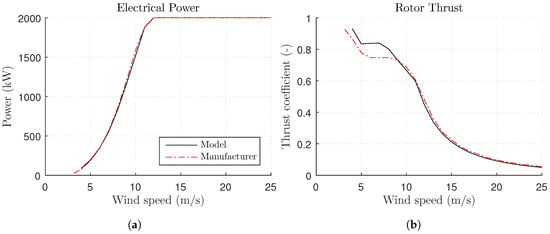
Figure 1.
Comparison of the manufacturer’s data and the developed model for the (a) electrical power and (b) rotor thrust as a function of the wind speed.
2.2. Actuator Disc Reynolds-Averaged Navier–Stokes Simulation
The k-- eddy-viscosity model [3,17] is used to model the turbulence in RANS. A log-law is used with a surface roughness of m over the entire domain to simulate the site vegetation. Ideally, should be based on measurement data, e.g., by considering the inflow profile according to measurements in the wind farm, however a rough estimate for was used instead. Figure 2a depicts the terrain and wind turbine setup for the AD-RANS where the wind turbine rotor diameter, D, is 93 m. In the AD-RANS setup, the mesh is cylindrical in shape with a radius of 28 km and a height of approximately 25 km. The 7.8 km terrain grid is situated at the center of the mesh at WT10, since WT10 is approximately located at the center of the wind farm. The cylindrical mesh allows variable wind directions without changing the grid. Inflow/outflow boundary conditions are applied on the outer-boundary of the mesh according to the wind direction. The velocities at the top and inlet boundaries are prescribed. The mesh contains 280 blocks with each block having 48 grid points. The terrain grid is 10 × 10 blocks. There are approximately 6 (horizontal) × 16 (vertical) grid cells on each AD.
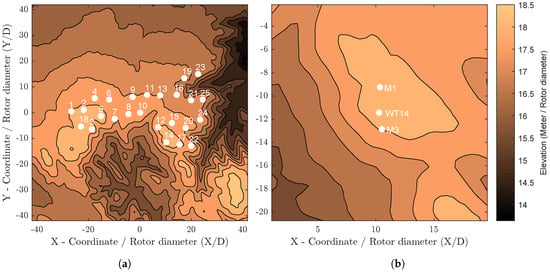
Figure 2.
Computational layouts of the (a) Shaanxi wind farm with twenty-five wind turbines and of (b) wind turbine 14 with met masts M1 and M3. The wind turbines are labeled from 1 to 25.
Given an amount of computational resources to work with, since the amount of computational resources is limited, the computational mesh is designed such that there is more grid points at the center to capture terrain effects and the effect of each AD on the flow field. At the center, the velocities gradients due to complex terrain and the wind turbine presence is greatest. Further away from the center and towards the cylindrical boundary of the mesh, a much coarser grid is used over a long distance to minimize the computational cost and at the same time reduce the effect of the boundary conditions on the flow field at the center. The computational grid gave slightly less than the recommended amount of grid points on each AD, which based on experience should be a minimum of 8 horizontal and 8 vertical grid cells [17]. The effect of a refined mesh, where the terrain grid is 24 × 10 blocks, is shown in Section 3.1.
Sensors are placed at hub height for all twenty-five wind turbines as well as on the met masts in the CFD setup. The (a) outer and (b) terrain computational grids for the AD-RANS computations are shown in Figure 3. Each AD-RANS computation is performed using one-hundred-and-forty 2.8 GHz processors on a Linux cluster, where each processor is allocated for two blocks out of the 280 blocks. Each AD-RANS computation requires approximately 3 to 4 h for completion.
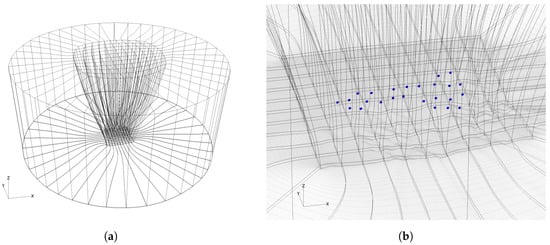
Figure 3.
(a) outer and (b) terrain computational grids used in the actuator disc Reynolds-averaged Navier-Stokes (AD-RANS) computations. The circles in (b) are the actuator discs.
2.3. Actuator Line Large-Eddy Simulation
Figure 2b depicts the terrain and wind turbine setup. The AL-LES provides much more detailed information about the wind flow than the AD-RANS, but at the expense of a much higher computational cost. Therefore, in contrast to the AD-RANS simulations of the entire Shaanxi wind farm, the AL-LES is applied to a much smaller area, specifically around WT14. The smaller area contains WT14 and the two met masts M1 and M3. The area around WT14 was selected because it is near the two met masts and the results from the simulations can be compared with measurements from the met masts. The terrain is centered at WT14 and is 1728 m in size. The mesh is also cylindrical in shape with a radius of 6.5 km, a height of approximately 3.2 km and contains a total of 1404 blocks. The terrain grid is 18 × 18 blocks. Each block contains 48 grid points as well. There is approximately 47 (horizontal) × 39 (vertical) grid cells on the rotor swept area, which is similar to the number of grid cells used in Refs. [10,18]. The boundary conditions are the same as in Section 2.2. The (a) outer and (b) terrain computational grids for the AL-LES computations are shown in Figure 4. Each AL-LES computation is performed using seven-hundred-and-to 2.8 GHz processors on a Linux cluster, where each processor is allocated for two blocks out of the 1404 blocks.
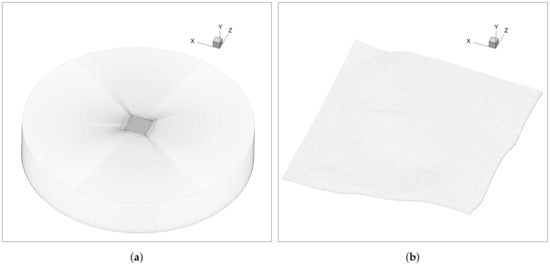
Figure 4.
(a) outer and (b) terrain computational grids used in the AL-LES computations.
To attain a flow field over the vicinity of WT14, the flow field in AL-LES was scaled using the sensor at 70 m height on the upstream met mast, since it has almost the same height as the wind turbine hub (67 m). For the 4 and 7 m/s at 180 degrees, the upstream and downstream met masts are M3 and M1, respectively. For the 4 and 7 m/s at 0 degree, the upstream and downstream met masts are M1 and M3, respectively. In addition, WT14, M1, and M3 are located at elevation levels of 1695, 1692, and 1678 m, respectively. To simulate the wind shear, a prescribed profile is imposed at the first time-step in the AL-LES using a shear exponent of 0.3, roughly estimated from the met-mast measurements.
Two sets of simulations are carried out: inflow with and without synthetic turbulence. The inflow simulations without synthetic turbulence are performed to scale the flow field more quickly, as mentioned above, since the computational cost is much less than the inflow simulations with synthetic turbulence. The AL-LES computations without and with synthetic inflow turbulence require approximately two and five days for completion, respectively. Simulations without synthetic inflow turbulence are performed until steady-state values for power, rotor RPM, and wind speed are achieved (i.e., approximately 34 s real time). Simulations with synthetic inflow turbulence are performed to obtain 600 s (10 min) of real time, excluding initial transients.
Synthetic inflow turbulence is simulated by prescribing a plane, 372 × 372 m in size, 2.5 rotor diameters upstream of the wind turbine. Turbulence boxes are generated as a pre-processing step using the Mann model [19,20] and slices from the box are gradually fed into the plane during the simulation. In an attempt to represent the high turbulence magnitudes observed in the measurements, a high surface roughness of 0.4 was selected to generate the turbulence boxes. The turbulence is induced in a square 2.5 rotor diameters upstream of the wind turbine because it is scaled, using the surface roughness in the Mann model, in an attempt to match the turbulence intensity seen in the measurements in that specific area of the domain. Of course, a much larger square can be imposed upstream of the wind turbine with a constant surface roughness to cover the entire domain. However, this would imply that the turbulence intensity is uniform across the entire domain, which is likely not the case. It is assumed that creating a plane larger than 372 × 372 m would not influence the results.
In addition, the magnitude of the turbulence released at the plane was multiplied by a scaling factor of 1.5. The scaling factor does not have a physical meaning and is used when comparing with measurements where the source of the additional turbulence observed in the measurements cannot be captured in the LES simulation alone. The time-averaged solutions from the simulations without and with synthetic inflow turbulence are compared to the mean values from SCADA.
2.4. Flow Cases
Based on twelve months of met mast and wind turbine measurements, nine wind farm flow cases (FC1) have been identified for comparing the AD-RANS simulations. The AD-RANS flow cases are shown in Table 2. The wind turbine furthest upstream and that is the least influenced by the wakes of nearby wind turbines is chosen as the wind speed reference in Table 2. The met masts were not used as references for the wind speed because they are influenced by the wakes of nearby wind turbines for the and wind directions. It was not possible to derive the wind direction from the wind turbine SCADA, thus the wind turbine could not be used as the wind direction reference. The met masts are used to determine the reference wind direction. Due to the large computational expense, only four cases (FC2) are investigated for the AL-LES simulations. The AL-LES flow cases are shown in Table 3. The met masts were used as reference for the wind speed and direction in FC2. The and m/s cases in Table 2 and Table 3 represent the bin intervals used to collect the SCADA measurements. Met mast and SCADA measurements used in the comparisons are filtered and represent neutral atmospheric conditions. Section 3 contains the AD-RANS and AL-LES simulation results for the FC1 and FC2 flow cases, respectively.

Table 2.
Inflow conditions for the actuator disc Reynolds-averaged Navier-Stokes (AD-RANS) flow cases (FC1) where h = height and WT = wind turbine.

Table 3.
Inflow conditions for the actuator line large-eddy simulation (AL-LES) flow cases (FC2) where h = height.
3. Results
The current section summarizes the results obtained from the AD-RANS and AL-LES simulations and their comparisons to the SCADA measurements. The results are divided into two subsections, actuator disc Reynolds-averaged Navier–Stokes and actuator line large-eddy simulation.
3.1. Actuator Disc Reynolds-Averaged Navier–Stokes Results
Prior to simulating the entire wind farm using AD-RANS, the inputs for the far upstream wind direction and speed should be modified to include the effect of the turning angle and speed-up. The wind direction and speed throughout the complex terrain will not be equal to the far upstream wind direction and speed where the terrain is assumed to be flat (see e.g., Figure 3). The flow will change direction and gain or lose speed when encountering, e.g., hills, valleys, and cliffs. For an accurate comparison with the measurements, the computed wind direction and speed at the reference met mast and wind turbine must take into account the effect of the turning angle and speed-up. The turning angle and speed-up are obtained from a pre-computation without wind turbines at the reference met mast and wind turbine locations, respectively. The turning angle and speed-up are calculated using the reference wind speed and direction as shown in Table 2. Table 4 summarizes the turning angles and speed-ups obtained for FC1. In the pre-computation without wind turbines, e.g., FC 1.1 in Table 4, the far upstream wind direction and speed were set to 180 degrees and 4 m/s, respectively. The wind direction and speed computed at M3 and WT14 was degrees and m/s, respectively. The far upstream wind direction and speed are then set to degrees and m/s to obtain approximately 180 degrees and 4 m/s at M3 and WT14, respectively.

Table 4.
Turning angles and speed-ups obtained for FC1.
Figure 5 contains the results for the flow cases defined in Table 2, which consist of the AD-RANS results and the comparisons with the measurement data from SCADA. The notation wd and ws shown in the title for each figure denotes wind direction and wind speed, respectively. The wind direction corresponds to the measurements on met masts M1 and M3, while the wind speed corresponds to the measurements on the reference wind turbine (ref. WT). The figure contains the predicted, labeled as AD# and AD# ± where # is the wind direction in degrees, and measured, labeled as SCADA, electrical power output for all 25 WTs. Each WT is labeled between 1 and 25, refer to Figure 2a. The AD# results represent a single run with the wind direction, #, which is also specified in the sub-figure titles. The AD# ± results represent the average of five runs: , , 0, , and degrees relative to wd. For example, AD# for FC 1.1 is a single run at 180 degrees (# = ), and AD# ± is the average of 5 runs: 180 − 5, 180 − 2, 180, 180 + 2, and 180 + 5 degrees. The SCADA measurements represent averaged values in ±5 degree bins. Although difficult to see, the standard error (SE) in Figure 5 is equal to SCADA ± but includes the error bars (may require zoom-in).
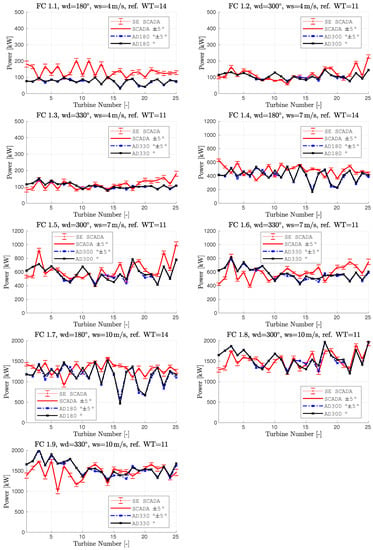
Figure 5.
Predicted power from AD-RANS (AD#) for wind turbines 1 to 25 compared to supervisory control and data acquisition (SCADA) for 4, 7 and 10 m/s wind speeds (ws) at wind directions (wd) of 180, 300 and 330 degrees. The wind speed, ws, is referenced from the reference wind turbine (ref. WT). SE is the standard error and # is the wind direction in degrees.
In Figure 5, AD# ± should more closely represent the SCADA measurements than AD#, since the SCADA measurements are grouped and averaged in ±5 degree bins. The SCADA results cannot be determined exactly at 180, 300 or 330 degrees in Figure 5. Nevertheless, the AD-RANS results in Figure 5 show that AD# ± is almost identical to AD#. In general, there is an agreement between the AD-RANS and the SCADA. However, there are significant differences in, for example, FC 1.1 for all the WTs and WT16 in FC 1.7. A possible explanation for the former case is that for the south wind at a small wind speed of 4 m/s, the wind distribution over the terrain may be non-uniform. Large variations in wind speed is captured in the SCADA but not in the RANS. The latter discrepancy is due to the delayed wake recovery caused by low dissipation in the employed turbulence model. The percent difference for the latter discrepancy is 57.4% and 66.4% based on AD# ± and AD#, respectively. The latter discrepancy is the same as observed in WT16 for FC 1.4 as well. Figure 6 shows the wind speed magnitude (a) for the entire wind farm and (b) in the vicinity of WT16 for FC 1.7. In Figure 6b, WT16 is in the wake of WT17 and possibly WT20 as well, despite being more than 10 diameters away. The higher power output for WT16 in the SCADA indicates that WT16 may not be influenced as much by the WT17 and WT20 wakes.

Figure 6.
Wind speed magnitude (a) for the entire wind farm and (b) in the vicinity of wind turbine 16 for FC 1.7.
The predicted power from AD-RANS for two terrain mesh grids: 10 × 10 (AD Base) and 24 × 10 blocks (AD Fine), compared to SCADA for a wind direction of 180 degrees at (a) 4 m/s, (b) 7 m/s and (c) 10 m/s is shown in Figure 7. The mesh with 24 × 10 blocks is shown in Figure 7d. In comparison to the terrain mesh with 10 × 10 blocks, the refined mesh has a greater concentration of points on the left (west) and right (east) sides to capture the terrain effects in greater detail. The non-uniform mesh results in between 7 and 15 horizontal grid points per AD. Figure 7a–c shows larger differences in predicted power between AD Fine and AD Base for larger wind speeds. A possible explanation is that the refined mesh includes more terrain detail, and the effects of terrain are pronounced at higher wind speeds. Nevertheless, refining the mesh did not result in significant improvements in comparison to SCADA measurements.
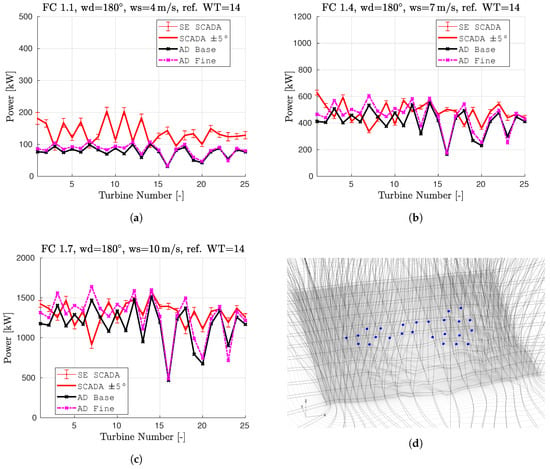
Figure 7.
Predicted power from AD-RANS for two terrain mesh grids: 10 × 10 (AD Base) and 24 × 10 blocks (AD Fine), compared to SCADA for a wind direction of 180 degrees at (a) 4 m/s, (b) 7 m/s and (c) 10 m/s. The mesh (d) with 24 × 10 blocks.
In summary, the comparison of the RANS simulations with the measurements is a challenging task. The wind directions and wind speeds are always changing in the wind farm, and this cannot be measured precisely. In other words, the reference wind directions and wind speeds are difficult to determine, which may lead to a high measurement uncertainty when the data is processed into bins. The significant changes in power levels between 0 and 360 degrees is seen in the power measurements. Percent differences obtained for power in the AD-RANS varied between 0.1% (FC 1.3, WT3) and 73.4% (FC 1.1, WT16) based on AD# ± . Based on AD#, minimum and maximum values are 0.1% (FC 1.7, WT12) and 78.4% (FC 1.1, WT16), respectively. The mean percent difference for power from all twenty-five wind turbines varied between 9.6% (FC 1.8) and 42.1% (FC 1.1) based on AD# ± , or 10.1% (FC 1.8) and 40.9% (FC 1.1) based on AD#. The mean percent difference for power from all flow cases is 20.5% and 20.0% for AD# ± and AD#, respectively. Therefore, averaging RANS simulations in the degree range may reduce extreme percent differences slightly (e.g., 78.4% down to 73.4% for FC 1.1, WT16), but does not reduce the mean percent difference.
3.2. Actuator Line Large-Eddy Simulation Results
Figure 8 depicts the iso-surface of vorticity for the AL-LES simulation without synthetic inflow turbulence of WT14 at the 7 m/s wind speed and 180 degrees wind direction, i.e., south to north. The comparison of AL-LES results with measurement data are shown in Table 5 and Figure 9, Figure 10 and Figure 11. In Table 5, the mean power (kW), rotor speed (RPM), and the horizontal streamwise velocity at 30, 50, and 70-m heights on met masts M1 and M3 for the four flow cases are shown. The table includes the results from the AL-LES in black, the mean measurement values in blue, and the percent difference between the AL-LES and the measurements in purple. The standard deviations (STDs) from the measurements for a 1-year period are also included in the table.
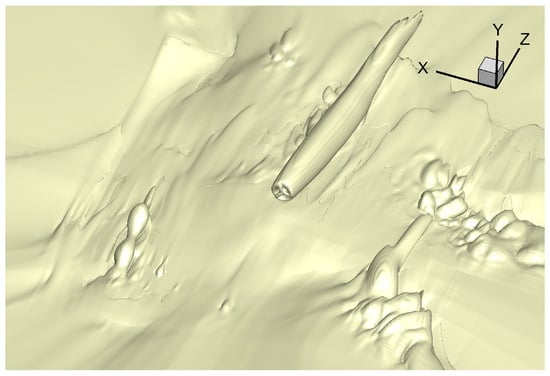
Figure 8.
Iso-surface of vorticity for the actuator line large-eddy simulation of wind turbine 14 without synthetic inflow turbulence for 7 m/s wind speed and 180 degrees wind direction (south to north). The domain shown is the same as in Figure 4b.

Table 5.
Summarized values from AL-LES without synthetic inflow turbulence in black, measurements in blue, and percent differences in purple for the FC2 flow cases. The flow field is scaled using the horizontal streamwise velocity (streamwise vel.) measured at the upstream met mast at 70 m (in bold). STD is the standard deviation of the measurements for a 1-year period.
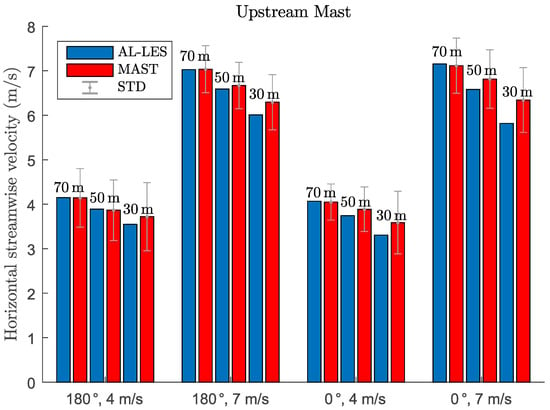
Figure 9.
Comparison of AL-LES without synthetic inflow turbulence and met mast data for the horizontal streamwise velocity at 30-, 50- and 70-m heights on masts M1 and M3 when M1 and M3 are upstream of wind turbine 14. STD is the standard deviation of the measurements for a 1-year period.
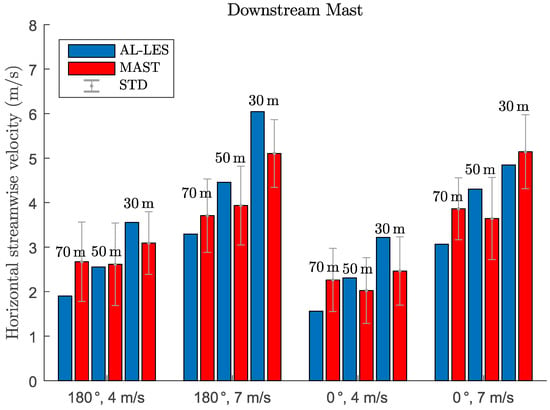
Figure 10.
Comparison of AL-LES without synthetic inflow turbulence and met mast data for the horizontal streamwise velocity at 30-, 50- and 70-m heights on masts M1 and M3 when M1 and M3 are downstream of wind turbine 14. STD is the standard deviation of the measurements for a 1-year period.
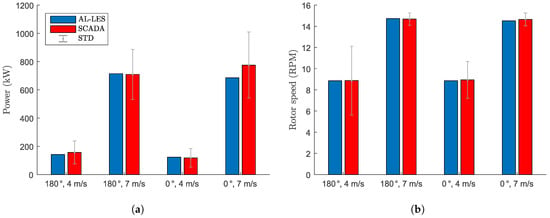
Figure 11.
Comparison of AL-LES without synthetic inflow turbulence and SCADA for (a) power and (b) rotor speed of wind turbine 14 for the four FC2 flow cases. STD is the standard deviation of the measurements or a 1-year period.
Larger percent differences were obtained for the horizontal streamwise velocities, particularly when comparing AL-LES and the measurements for the met mast located downstream of WT14. For example, the percent difference in the horizontal streamwise velocity at 70 m height on met mast M1 for the 180 degrees and 4 m/s flow case is 28.81%. The reason for the large difference is because M1 is located downstream of WT14 as shown in Figure 2b. The complexity and stochastic nature of the turbulence from the wake of WT14 introduces larger variations and uncertainty in the flow field. There is a reasonable agreement between the AL-LES and the measurements for the power and rotor speed on WT14, the largest percent difference being 11.60% in power for the 0 degree and 7 m/s flow case. The smallest percent difference is 0.08% in rotor speed for the 180 degrees and 4 m/s flow case. The mean percent differences from the four flow cases for power and rotor speed are 6.54% and 0.53%, respectively.
Figure 9, Figure 10 and Figure 11 are the results in Table 5 displayed in a bar-chart format. The results for the horizontal streamwise velocity comparisons are grouped by upstream (Figure 9) and downstream (Figure 10) locations. In Figure 9 and Figure 10, bars are paired to represent comparisons between AL-LES and measurements for each one of the sensor locations: 70 m, 50 m and 30 m heights on the met mast. The horizontal streamwise velocity comparisons for the upstream mast in Figure 9 are in better agreement than the comparisons for the downstream mast shown in Figure 10 for two reasons. First, as mentioned in Section 2.3, the flow field in the AL-LES was scaled with the measurements using the sensor at 70 m height on the upstream met mast. Second, as mentioned previously for Table 5, larger differences occur for the downstream mast because of the complexity and stochastic nature of the turbulence generated from the wake of WT14. The wake of WT14 introduces larger variations and uncertainty in the flow field. In Figure 11, the largest difference between the AL-LES and SCADA appears for the power in the 0 and 7 m/s flow case. All the other comparisons in Figure 11 generally agree.
Figure 12 depicts the iso-surface of vorticity for the AL-LES simulation of WT14 with synthetic inflow turbulence at the 7 m/s wind speed and 180 degrees wind direction. In Figure 12, the synthetic turbulent inflow input is seen by the rectangular plane, 372 × 372 m in size, 2.5 rotor diameters upstream of the wind turbine. Since slices from the Mann turbulence box were gradually fed into the plane during the unsteady simulation, a rectangular box is seen encompassing the wind turbine and its wake. The comparison of AL-LES results with measurement data is shown in Table 6.

Figure 12.
Iso-surface of vorticity for the actuator line large-eddy simulation of wind turbine 14 with synthetic inflow turbulence for 7 m/s wind speed and 180 degrees wind direction (south to north). The domain shown is the same as in Figure 4b. The synthetic inflow turbulence input is seen by the rectangular plane 2.5 rotor diameters upstream of the wind turbine.

Table 6.
Summarized values from AL-LES with synthetic inflow turbulence in black, measurements in blue, and percent differences in purple for the FC2 flow cases. The flow field is scaled using the horizontal streamwise velocity (streamwise vel.) measured at the upstream met mast at 70 m (in bold). STD is the standard deviation of the measurements for a 1-year period.
The flow field in the AL-LES simulation with synthetic inflow turbulence was scaled using the sensor at 70 m height on the upstream met mast based on the simulations without synthetic inflow turbulence. The scaling is more difficult and not as accurate as in the case without synthetic inflow turbulence because of the large variation in wind speed in the AL-LES simulation with synthetic inflow turbulence. For example, for the 7 m/s wind speed and 0 degree wind direction case at 70 m on M1, the percent difference between the measurement and the AL-LES is 1.81%. For the case without synthetic inflow turbulence in Table 5, the percent difference is only 0.58%. The percent differences obtained for the horizontal streamwise velocity at 30-, 50- and 70-m heights on masts M1 and M3 are similar to the case without synthetic inflow turbulence. The percent differences obtained for the power and RPM are also similar. The percent differences obtained for power and RPM vary between 0.44% and 11.42%. The mean percent differences from the four flow cases for power and rotor speed are 6.77% and 1.47%, respectively. Figure 13, Figure 14 and Figure 15 are the results in Table 6 displayed in a bar-chart format identical to Figure 9, Figure 10 and Figure 11. All comparisons in Figure 13, Figure 14 and Figure 15 are very similar to Figure 9, Figure 10 and Figure 11.
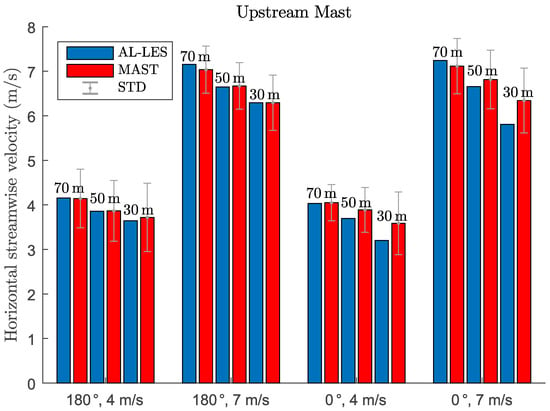
Figure 13.
Comparison of mean AL-LES results with synthetic inflow turbulence and met mast data for the horizontal streamwise velocity at 30-, 50- and 70-m heights on masts M1 and M3 when M1 and M3 are upstream of wind turbine 14. STD is the standard deviation of the measurements for a 1-year period.
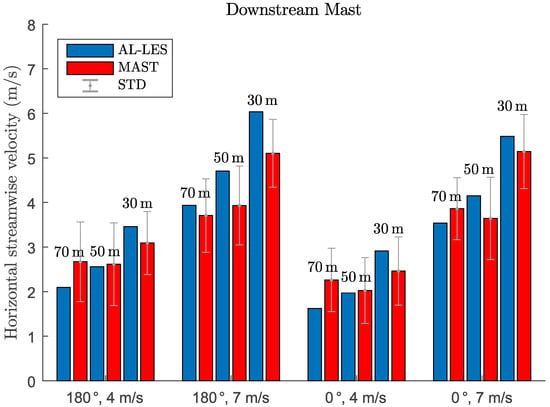
Figure 14.
Comparison of mean AL-LES results with synthetic inflow turbulence and met mast data for the horizontal streamwise velocity at 30-, 50- and 70-m heights on masts M1 and M3 when M1 and M3 are downstream of wind turbine 14. STD is the standard deviation of the measurements for a 1-year period.
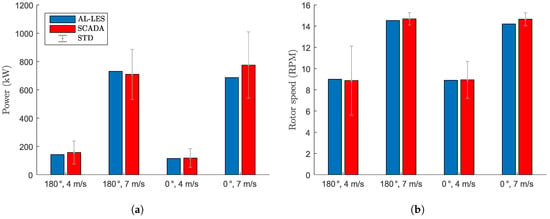
Figure 15.
Comparison of mean AL-LES results with synthetic inflow turbulence and SCADA for (a) power and (b) rotor speed of wind turbine 14 for the four FC2 flow cases. STD is the standard deviation of the measurements for a 1-year period.
The turbulence intensities based on the horizontal streamwise velocity in Table 6 are shown in bar-chart format in Figure 16 and Figure 17. It was not possible to attain very good agreement for the turbulence intensities. The highest percent difference is 55.23% at 30 m on M1 for the 4 m/s and 180 degrees case. The turbulence intensities obtained from the AL-LES largely depended on the chosen input parameters for the surface roughness (=0.4) when generating the Mann turbulence box and the turbulence scaling factor (=1.5), see Section 2.3.
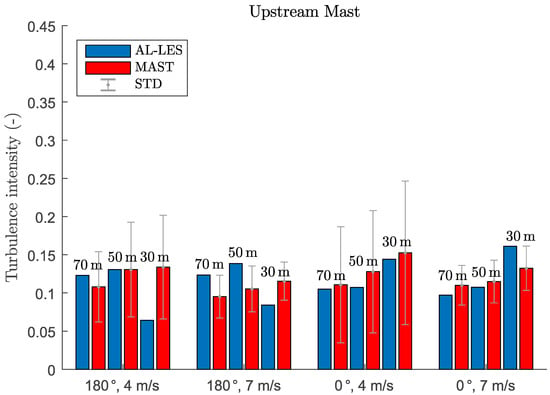
Figure 16.
Comparison of mean AL-LES results with synthetic inflow turbulence and met mast data for turbulence intensities at 30-, 50- and 70-m heights on masts M1 and M3 when M1 and M3 are upstream of wind turbine 14. The turbulence intensities are based on the horizontal streamwise velocity and STD is the standard deviation of the measurements for a 1-year period.
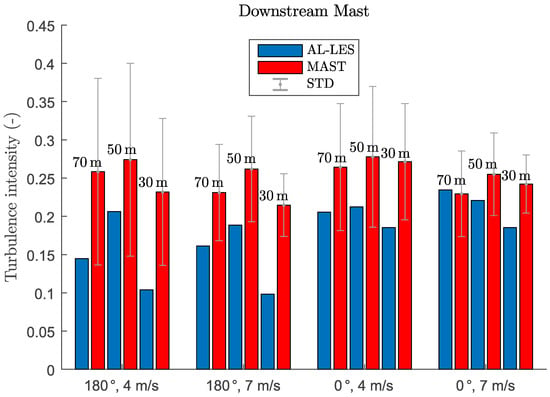
Figure 17.
Comparison of mean AL-LES results with synthetic inflow turbulence and met mast data for turbulence intensities at 30-, 50- and 70-m heights on masts M1 and M3 when M1 and M3 are downstream of wind turbine 14. The turbulence intensities are based on the horizontal streamwise velocity and STD is the standard deviation of the measurements for a 1-year period.
4. Conclusions
This article described Computational Fluid Dynamics (CFD) simulations of flows in a wind farm in complex terrain in Shaanxi, China and the comparisons of the computational results with utility scale field measurements. The CFD simulations in the study were performed using Reynolds-Averaged Navier–Stokes (RANS) and Large-Eddy Simulation (LES) solvers. The RANS method together with an Actuator Disc (AD) approach was employed to predict the performance of the 25 wind turbines in the farm, while the LES method with an Actuator Line (AL) technique was used to obtain a detailed description of the flow field around one specific wind turbine near two met masts. The AD-RANS simulation results were compared with the mean values of power obtained from field measurements. Furthermore, the AL-LES results were compared with the mean values of power, rotor speed, and streamwise velocity measured from the wind turbine and its nearby two masts.
Results from both the AD-RANS and AL-LES simulations indicated that both methods can reasonably predict the flow patterns and performance of the wind farm and wind turbine #14, respectively, in complex terrain in Shaanxi. The mean percent difference obtained for power in the AD-RANS simulations was approximately 20%. Percent differences obtained for power and rotor RPM in the AL-LES varied between 0.08% and 11.6%. The mean percent differences in the AL-LES for power and rotor RPM are approximately 7% and 1%, respectively. Careful consideration of the measurement data as well as the computational setup, such as the meshing of terrain and flow domain, wind turbine model and wind farm layout, and the flow input parameters is needed to obtain reasonable or improved results. Uncertainty quantification and statistical models should be employed. For example, the uncertainty in the measurement data can be incorporated into the CFD solver to provide more reliable outputs of power, rotor rotational speed, wind velocities, etc.
Author Contributions
W.Z.S. and K.S.H. conceived and designed the project; M.S. performed the computations and analyzed the results under the guidance of M.P.v.d.L. and W.J.Z.; M.S., W.Z.S. and M.P.v.d.L. wrote the paper.
Funding
This research was supported by the Sino-Danish cooperative project “Wind farm layout optimization in complex terrain” funded by the Danish Energy Agency (EUDP J.nr. 64013-0405) and the Ministry of Science and Technology of China (NO. 2014DFG62530).
Acknowledgments
The authors wish to give special thanks to the Danish and Chinese partners (DTU Wind Energy, EMD International A/S, North West Survey and Design Institute of Hydro China Consultant Corporation, and HoHai University) for their active collaborations.
Conflicts of Interest
The authors declare no conflict of interest.
Abbreviations
The following abbreviations are used in this manuscript:
| AD | actuator disc |
| AL | actuator line |
| CFD | computational fluid dynamics |
| CSIC | China Shipbuilding Industry Corporation |
| DES | delayed-detached-eddy simulation |
| FC1/FC2 | flow case 1, flow case 2 |
| HZ | Haizhuang |
| LES | large-eddy simulation |
| MW | megawatt |
| RANS | Reynolds-Averaged Navier–Stokes |
| RPM | revolutions per minute |
| SCADA | supervisory control and data acquisition |
| SE | standard error |
| SGS | sub-grid scale |
| STD | standard deviation |
| wd | wind direction |
| ws | wind speed |
| WT(s) | wind turbine(s) |
References
- International Renewable Energy Agency. Renewable Power Generation Costs in 2017; Technical Report; IRENA: Abu Dhabi, UAE, 2018; ISBN 978-92-9260-040-2. [Google Scholar]
- Storey, R.C.; Norris, S.E.; Stol, K.A.; Cater, J.E. Large eddy simulation of dynamically controlled wind turbines in an offshore environment. Wind Energy 2013, 16, 845–864. [Google Scholar] [CrossRef]
- Van der Laan, M.P.; Sørensen, N.N.; Réthoré, P.E.; Mann, J.; Kelly, M.C.; Troldborg, N. The k-ε-fP model applied to double wind turbine wakes using different actuator disk force methods. Wind Energy 2015, 18, 2223–2240. [Google Scholar] [CrossRef]
- Makridis, A.; Chick, J. Validation of a CFD model of wind turbine wakes with terrain effects. J. Wind Eng. Ind. Aerodyn. 2013, 123, 12–29. [Google Scholar] [CrossRef]
- Schulz, C.; Klein, L.; Weihing, P.; Lutz, T.; Krämer, E. CFD Studies on Wind Turbines in Complex Terrain under Atmospheric Inflow Conditions. J. Phys. Conf. Ser. 2014, 524, 012134. [Google Scholar] [CrossRef]
- Schulz, C.; Klein, L.; Weihing, P.; Lutz, T. Investigations into the Interaction of a Wind Turbine with Atmospheric Turbulence in Complex Terrain. J. Phys. Conf. Ser. 2016, 753, 032016. [Google Scholar] [CrossRef]
- Tabib, M.; Rasheed, A.; Kvamsdal, T. LES and RANS simulation of onshore Bessaker wind farm: Analysing terrain and wake effects on wind farm performance. J. Phys. Conf. Ser. 2015, 625, 012032. [Google Scholar] [CrossRef]
- Tabib, M.; Rasheed, A.; Fuchs, F. Analyzing complex wake-terrain interactions and its implications on wind-farm performance. J. Phys. Conf. Ser. 2016, 753, 032063. [Google Scholar] [CrossRef]
- Castellani, F.; Astolfi, D.; Mana, M.; Piccioni, E.; Becchetti, M.; Terzi, L. Investigation of terrain and wake effects on the performance of wind farms in complex terrain using numerical and experimental data. Wind Energy 2017, 20, 1277–1289. [Google Scholar]
- Sørensen, J.N.; Mikkelsen, R.F.; Henningson, D.S.; Ivanell, S.; Sarmast, S.; Andersen, S.J. Simulation of wind turbine wakes using the actuator line technique. Philos. Trans. Ser. A Math. Phys. Eng. Sci. 2015, 373, 20140071. [Google Scholar] [CrossRef] [PubMed]
- Sørensen, N.N. General Purpose Flow Solver Applied to Flow over Hills. Ph.D. Thesis, Technical University of Denmark, Roskilde, Denmark, 1995. [Google Scholar]
- Michelsen, J.A. Basis3D—A Platform for Development of Multiblock PDE Solvers; Technical Report; Technical University of Denmark: Roskilde, Denmark, 1992. [Google Scholar]
- Réthoré, P.E.; van der Laan, P.; Troldborg, N.; Zahle, F.; Sørensen, N.N. Verification and validation of an actuator disc model. Wind Energy 2014, 17, 919–937. [Google Scholar] [CrossRef]
- Sørensen, J.N.; Shen, W.Z. Numerical Modeling of Wind Turbine Wakes. J. Fluids Eng. 2002, 124, 393–399. [Google Scholar] [CrossRef]
- Ramos-García, N.; Sørensen, J.N.; Shen, W.Z. A strong viscous-inviscid interaction model for rotating airfoils. Wind Energy 2014, 17, 1957–1984. [Google Scholar] [CrossRef]
- Han, X.; Liu, D.; Xu, C.; Shen, W.Z. Atmospheric stability and topography effects on wind turbine performance and wake properties in complex terrain. Renew. Energy 2018, 126, 640–651. [Google Scholar] [CrossRef]
- Van der Laan, M.P.; Sørensen, N.N.; Réthoré, P.E.; Mann, J.; Kelly, M.C.; Troldborg, N.; Schepers, J.G.; Machefaux, E. An improved k-ε model applied to a wind turbine wake in atmospheric turbulence. Wind Energy 2015, 18, 889–907. [Google Scholar] [CrossRef]
- Andersen, S.J.; Sørensen, J.N.; Mikkelsen, R. Simulation of the inherent turbulence and wake interaction inside an infinitely long row of wind turbines. J. Turbul. 2013, 14, 1–24. [Google Scholar] [CrossRef]
- Mann, J. The spatial structure of neutral atmospheric surface-layer turbulence. J. Fluid Mech. 1994, 273, 141–168. [Google Scholar] [CrossRef]
- Mann, J. Wind field simulation. Probab. Eng. Mech. 1998, 13, 269–282. [Google Scholar] [CrossRef]
© 2018 by the authors. Licensee MDPI, Basel, Switzerland. This article is an open access article distributed under the terms and conditions of the Creative Commons Attribution (CC BY) license (http://creativecommons.org/licenses/by/4.0/).